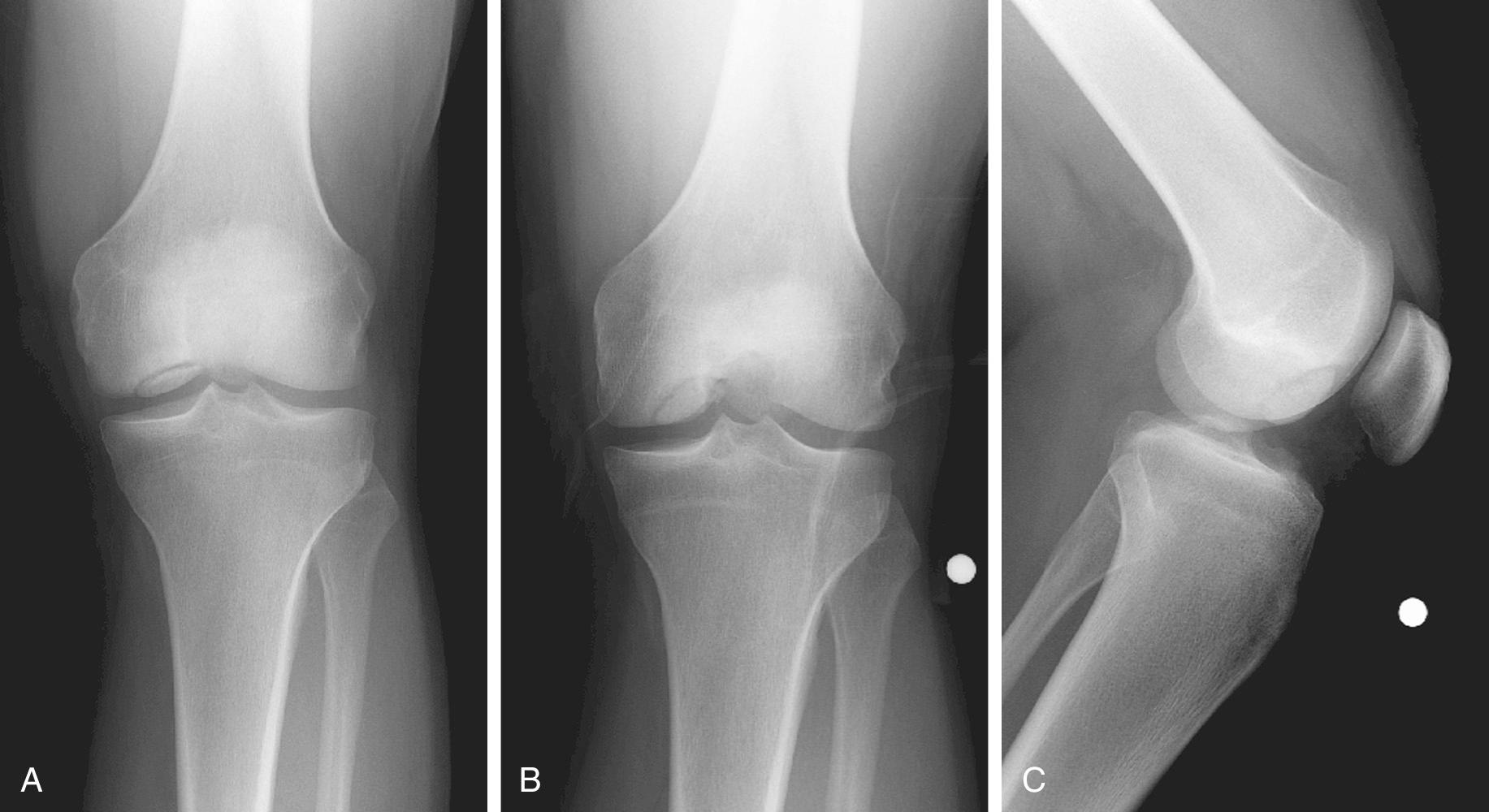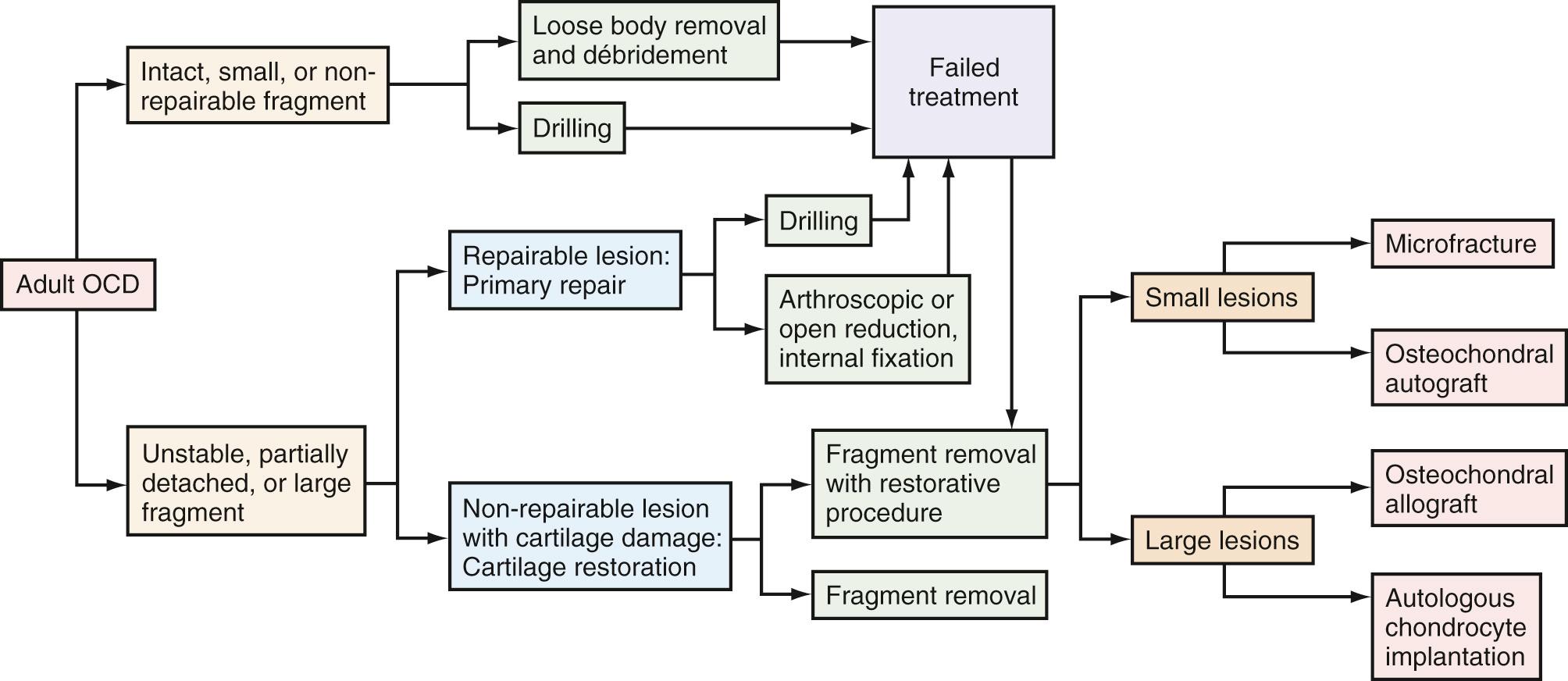Physical Address
304 North Cardinal St.
Dorchester Center, MA 02124
Osteochondritis dissecans (OCD) is a pathologic process in which the subchondral bone and the overlying articular cartilage detach from the underlying bony surface. The disease results in subchondral bone loss and destabilization of the overlying articular cartilage, leading to separation and increased susceptibility to stress and shear. Fragmentation of both cartilage and bone leads to early degenerative changes and loss of function in the affected compartment. The true cause is unknown but is likely related to repetitive microtrauma, acute traumatic incident, ischemia, an ossification abnormality, or endocrine or genetic predisposition.
The prevalence of OCD is estimated at 15 to 30 cases per 100,000, most frequently occurring in the knee, with medial femoral condyle (MFC) involvement in 80% of cases, lateral femoral condyle in 15%, and patellofemoral in 5%. The lateral aspect of the MFC is the classic site of the OCD lesion. In addition to the knee, OCD has the propensity of occurring in the elbow, wrist, and ankle.
OCD is divided into juvenile (JOCD) and adult (AOCD) forms. The distinction between JOCD (open growth plates) and AOCD (closed growth plates) may be important in treatment and prognosis. JOCD often resolves with nonoperative management and has a much better prognosis compared with AOCD, which, once symptomatic, can follow a progressive, unremitting course.
Nonoperative treatments for symptomatic cases are rarely an option because of the inherent poor regenerative capacity of articular cartilage. Thus, cases of AOCD usually require surgical intervention, such as loose body removal, drilling, internal fixation, marrow stimulation, autologous chondrocyte implantation (ACI), or osteochondral autograft/allograft transplantation, to replace the damaged cartilage. In advanced cases, joint replacement may be the only feasible solution.
A patient with an OCD lesion complains primarily of pain and swelling of the affected joint, which can be triggered by physical activity. In the presence of a loose body, mechanical symptoms such as clicking, popping, and locking may accompany the primary complaints.
On physical examination, patients present with tenderness overlying the OCD region. Patients often present with an antalgic gait. If the OCD lesion is present in the classic location, the lateral aspect of the MFC, the patient will ambulate with the affected leg in relative external rotation (Wilson sign) to decrease contact of the lesion with the medial tibial eminence. Joint effusion, decreased range of motion, and quadriceps atrophy are also variably present, depending on the severity and duration of the lesion.
Patellar OCD most often presents with patellofemoral pain, followed by swelling. Feelings of a loose body, locking, or giving way, or episodes of patellar subluxation, may also be noted. On examination, patients have retropatellar crepitus or pain and effusion.
Unfortunately, none of the physical findings observed during the examination can be used specifically to diagnose OCD; therefore confirmatory x-ray, magnetic resonance imaging (MRI), or computed tomography (CT) scans are required. Plain x-ray films should include standard anteroposterior, flexion weight-bearing anteroposterior (tunnel view), lateral, and Merchant views ( Fig. 28.1 ). Flexion weight-bearing anteroposterior in addition to standard anteroposterior allows better visualization of lesions along the posterolateral aspect of the MFC. Radiographic images of patients with AOCD show a lesion that typically appears as an area of osteosclerotic bone, with a high-intensity line between defect and epiphysis.

MRI is the mainstay in the diagnosis of OCD lesions and is the most informative imaging modality in the preoperative workup of OCD. Specifically, the quality of bone edema, subchondral separation, and cartilage condition are evaluated before treatment. MRI can reliably indicate lesion size, location, and depth, providing insight into a patient's knee condition ( Fig. 28.2 ). MRI images are assessed according to the criteria presented in the following list. Meeting one of the four criteria offers up to 97% sensitivity and 100% specificity in predicting lesion stability.
Thin, ill-defined, or well-demarcated line of high signal intensity, measuring 5 mm or more in length at the interface between the OCD lesion and underlying subchondral bone.
Discrete rounded area of homogeneous high signal intensity, 5 mm or more in diameter beneath the lesion.
Focal defect with an articular surface of the lesion with a width of 5 mm or more.
High signal intensity line traversing the articular cartilage and subchondral bone plate into the lesion.

Furthermore, OCD lesions can be classified by MRI findings according to whether the lesion is attached, partially attached, or completely detached from the parent bone ( Table 28.1 ). Other imaging modalities such as CT scans are also used, which can be greatly beneficial in revealing the exact location and extent of the lesion.
| Stage | Magnetic Resonance Imaging Findings |
|---|---|
| 0 | Normal |
| I | Signal changes consistent with articular cartilage injury, without disruption, and with normal subchondral bone |
| II | High-grade signal intensity; breach of the articular cartilage with a stable subchondral fragment |
| III | Partial chondral detachment with a thin high-signal rim (on T2-weighted images) behind the osteochondral fragment, representing synovial fluid |
| IV | Loose body in the center of the osteochondral fragment or free in the joint space |
Although the role of diagnostic imaging of OCD has been established, its usefulness in postoperative assessment is uncertain. Imaging has the advantage over second look arthroscopy by being noninvasive and able to appreciate subchondral structures; however, prognostic capabilities have yet to be reliably produced. Windt et al. performed a systematic review of 32 articles that assessed MRI imaging as a predictor of clinical outcome, and only nine found a positive correlation. In these studies, magnetic resonance observation of cartilage repair tissue (MOCART) was used to assess cartilage condition. It is the consensus of the American Academy of Orthopaedic Surgeons that patients treated surgically for OCD that remain symptomatic should be further examined and/or imaged.
The definitive cause of OCD has yet to be established. A number of factors may contribute, such as repetitive microtrauma, acute stress and injury, restricted blood supply, endocrine abnormalities, and genetic predisposition. Physical trauma is thought to be one of the major contributory factors in the development of OCD. Repetitive trauma to the joint leads to redundant healing, interrupting the blood supply to subchondral bone and possibly leading to avascular necrosis. In adults, high-impact sports such as soccer, basketball, football, and weightlifting may put the athlete at higher risk of developing OCD. Endocrine abnormalities affecting calcium and phosphorus homeostasis or anomalies of bone formation can compromise the blood supply to subchondral bone and progress to avascular necrosis. Recent reports have suggested a genetic predisposition to OCD.
Most AOCD cases arise from established but untreated or asymptomatic JOCD. However, many patients with AOCD present with a history of knee pain that began when they had open physes. These cases probably represent JOCD that did not heal and evolved to AOCD. An exception to this progression is JOCD that heals spontaneously; however, such lesions usually are not present in the classic location, which is the lateral aspect of the MFC. AOCD may also arise de novo.
The natural history of untreated OCD is poorly defined. Neither the literature nor our experience allows us to definitively determine whether untreated OCD has a higher likelihood of progressing to symptomatic degenerative joint disease (DJD) in the future. Linden performed a long-term retrospective follow-up study on patients with OCD of the femoral condyles, with an average follow-up of 33 years after initial diagnosis. The author concluded that OCD occurring prior to closure of the physes (JOCD) does not lead to additional complications later in life, but patients who manifest OCD after closure of the physes (AOCD) develop osteoarthritis 10 years earlier than the normal population. In contrast, Twyman et al. evaluated 22 knees with JOCD and found that 50% had some radiographic signs of osteoarthritis at an average follow-up of 34 years. The likelihood of developing osteoarthritis was also found to be proportional to the size of the area involved. The authors believe that lateral femoral condyle OCD has a poorer prognosis, but not all of these cases will become symptomatic over time, despite radiographic changes.
The ideal goal of conservative treatment is to attain lesion healing, which occurs more often before physeal closure. Stable OCD lesions in young patients have a favorable prognosis when treated initially with nonoperative treatment. Nonoperative treatment options include modified activity with decreased weight-bearing, anti-inflammatory medications, and management of patient symptoms. Traditional nonoperative treatment consists of an initial phase of knee immobilization with partial weight bearing to prevent repeated microtrauma lesions. Once the patient is pain free, weight bearing as tolerated is permitted, and a rehabilitation program emphasizing knee range of motion and low-impact strengthening exercises ensues. The goal is to promote healing in the subchondral bone and prevent chondral separation. X-rays are usually taken 3 months after the start of nonsurgical therapy to assess the status of the lesion and the condition of the subchondral bone. If the lesion reveals adequate healing, patients are allowed to gradually return to activities; if no change is observed, x-ray assessment is repeated in 3 months.
Surgical options are considered more often than not for AOCD because articular cartilage presents with an inherent poor ability to repair itself. Surgical options include loose body removal, drilling of the subchondral bone, internal fixation of the fragment, microfracture, osteochondral autografting and allografting, and ACI. The overall goal of such intervention is to enhance the healing potential of the subchondral bone, fix the unstable fragment, and replace damaged bone and cartilage with implantable tissue.
The type and extent of surgery necessary for OCD depend on the patient's age, characteristics of the lesion (quality of articular cartilage; size of associated subchondral bone; and shape, thickness, and location of the lesion), diagnostic information provided by MRI and arthroscopy, and preference of the operating surgeon. The author's preferred algorithm for treatment of OCD lesions is shown in Fig. 28.3 .

All patients are placed supine, with the leg supported by a standard thigh holder and the knee flexed at 90 degrees. The affected extremity is prepared and draped to the proximal thigh to ensure easy access to the knee. Examination under anesthesia assesses range of motion and ligamentous integrity. Lesions on the surfaces of the femoral condyle can usually be accessed using an arthroscopic approach. Standard portals are used and accessory portals are added when needed to improve visibility. More challenging locations, such as the patella and tibial plateau, may require an arthrotomy for better visualization and treatment.
A complete diagnostic arthroscopic evaluation of the structures in each compartment is performed. When the lesions are identified, a probe is used to determine the stability of the fragment ( Fig. 28.4 ). Guhl's intraoperative classification is defined by cartilage integrity and fragment stability ( Table 28.2 ).

| Stage | Arthroscopic Findings |
|---|---|
| I | Normal |
| II | Fragmentation in situ |
| III | Partial detachment |
| IV | Complete detachment, loose body present |
Become a Clinical Tree membership for Full access and enjoy Unlimited articles
If you are a member. Log in here